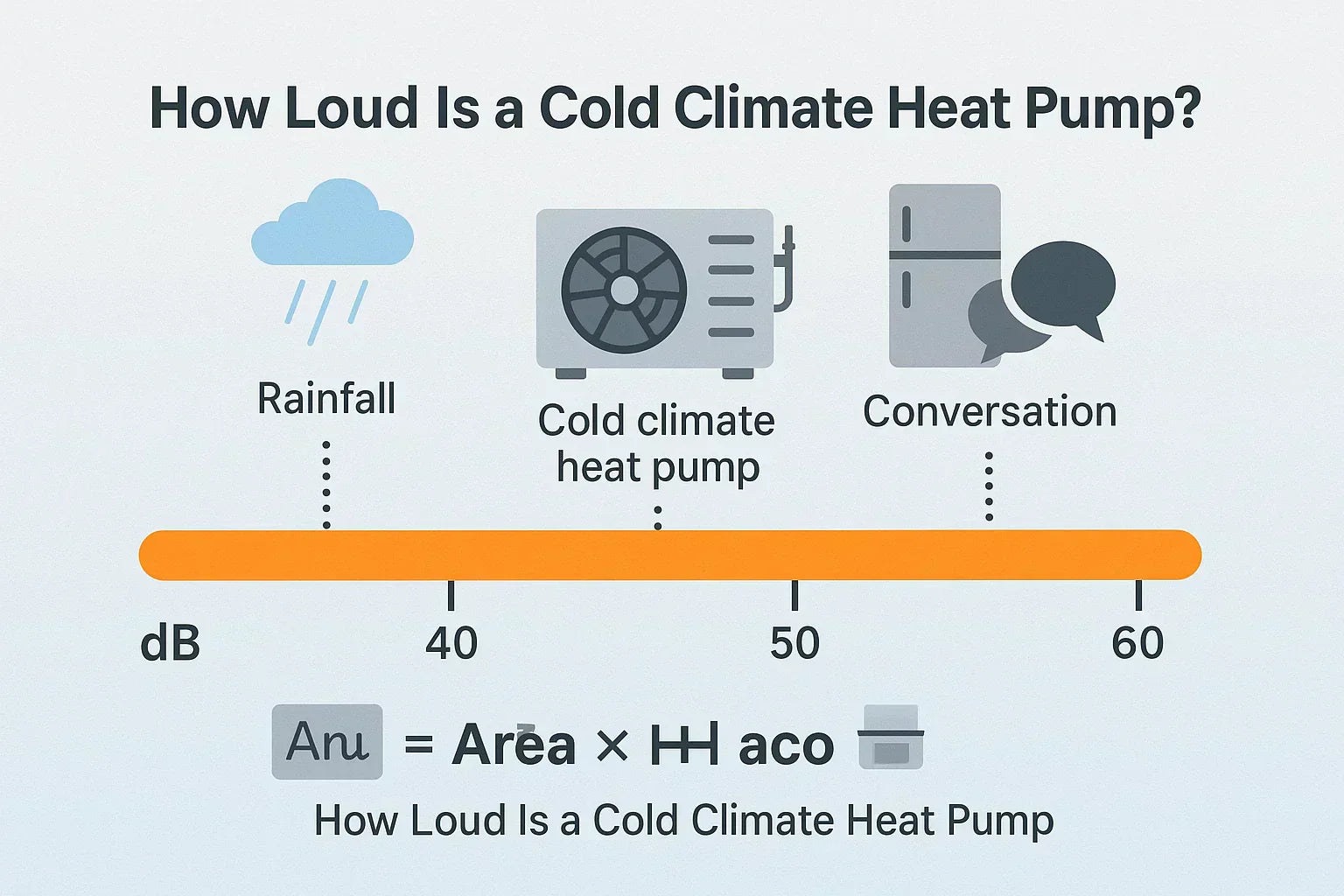If you’re upgrading to a cold climate heat pump, odds are you’ve asked: “How loud is it going to be?” It’s a fair concern—especially for homeowners switching from traditional furnaces or boilers, which often operate out of sight and out of mind.
The good news? Today’s cold climate heat pumps are some of the quietest HVAC systems available. But they’re not silent—and depending on the model, outdoor temperature, and installation, you may hear a range of normal operating sounds.
Let’s break down what “normal” really sounds like, how to spot red flags, and which 2025 models offer the quietest performance for cold weather use.
What Makes a Heat Pump Loud or Quiet?
Several components contribute to a heat pump’s noise profile. Some are always active, while others cycle depending on demand and outdoor temperature.
Key Noise Sources:
-
Outdoor compressor: Typically the loudest part of the system
-
Fan motor: Constant airflow means you’ll hear a gentle hum
-
Defrost mode: The loudest cycle, often mistaken for a problem
-
Refrigerant lines: Can vibrate if poorly installed
-
Indoor air handler: Usually quiet, but audible during peak output
What keeps noise down in modern systems is inverter technology. Inverter-driven compressors ramp up or down slowly based on demand—eliminating the loud “kick on” noise that older single-stage systems produce.
📘 Carrier offers a helpful overview of common heat pump sounds
Typical Sound Levels for Cold Climate Heat Pumps
Heat pump noise is measured in decibels (dB). Here's how modern systems stack up in real-world use:
| Component | Normal dB Range |
|---|---|
| Outdoor unit (running) | 45–60 dB |
| Outdoor unit (defrost) | Up to 70 dB (briefly) |
| Indoor air handler | 25–35 dB |
| Background home noise (TV, fridge) | 40–50 dB |
For context:
-
40 dB = whisper or library
-
50 dB = quiet refrigerator
-
60 dB = normal conversation
-
70 dB = vacuum cleaner
📘 Mitsubishi Comfort notes that their Hyper-Heating systems run as low as 45 dB—even under load.
How Cold Weather Impacts Heat Pump Noise
Cold weather doesn’t just affect heat pump efficiency—it can also change how it sounds. Here’s why:
1. Defrost Mode
When ice builds up on the outdoor coil, the system temporarily reverses flow to melt it. This cycle can produce:
-
A rushing or “whoosh” noise
-
Louder fan speeds
-
Brief compressor strain sounds
It only lasts a few minutes but can be surprising if you’ve never heard it before.
2. Harder Startups
On extremely cold mornings, compressors work harder to initiate heating, especially if the unit is not inverter-driven. You may hear a low growl or vibration on startup.
3. Longer Fan Run Times
To maintain comfort at low outdoor temps, the system may run the fan longer and more frequently—resulting in a steady hum.
📘 For a deeper technical explanation of HVAC system noise—especially airflow, vibration, and defrost cycle behavior—check out this HVAC Systems Noise Control guide from CED Engineering.
Quietest Cold Climate Heat Pump Models (2025)
Not all heat pumps are created equal when it comes to sound. Here are a few models consistently praised for quiet operation:
Mitsubishi Hyper-Heating H2i®
-
Outdoor noise level: ~45 dB
-
Features: Inverter compressor, insulated cabinet, slow ramp-up
Lennox SL25XPV
-
Outdoor noise level: As low as 58 dB
-
Features: Fully insulated cabinet, variable capacity, industry-best SEER2 and HSPF2 ratings
Carrier Infinity® with Greenspeed®
-
Outdoor noise level: ~55 dB average
-
Features: Inverter modulation, Wi-Fi thermostat pairing, sound-dampening technology
Daikin Aurora™
-
Outdoor noise level: 50–60 dB depending on capacity
-
Features: Built for low-temp climates, reliable and moderate noise profile
📘 Each of these units appears on the ENERGY STAR Most Efficient 2025 list, which considers both performance and sound levels.
Tips to Minimize Heat Pump Noise
Even the best system can be noisy if it’s poorly installed. Here’s how to keep things whisper-quiet:
1. Install on a Sound-Dampening Base
Concrete pads or isolation blocks with rubber feet reduce vibration transmission into the home’s structure.
2. Maintain Proper Clearance
Avoid placing the unit near solid walls or fence corners. These reflect and amplify sound.
3. Use Wind Baffles or Snow Hoods
These help reduce noise from high-speed fan operation and defrost splashback during winter storms.
4. Isolate Refrigerant Lines
Secure line sets to framing with soft clamps or foam wrap to prevent humming or rattling indoors.
Final Thoughts from Alex Lane
A heat pump that keeps you warm through freezing temperatures and operates quietly? It’s not too good to be true. In fact, it’s becoming the standard.
Cold climate heat pumps are quieter than ever thanks to inverter technology and better sound insulation—but it’s still important to understand what’s normal and what’s not. Don’t panic at the whoosh of defrost or a cold-morning rumble. Know what to expect, and you’ll enjoy quiet, efficient comfort all winter long.
👉 Want to explore top-rated models that deliver reliable heat and peace and quiet? Start here: Best Heat Pumps for Cold Climates in 2025
👉 Curious what these systems will cost you, installed? Read next: Installation Costs for Cold Climate Heat Pumps in 2025
Alex Lane
Your Home Comfort Advocate







